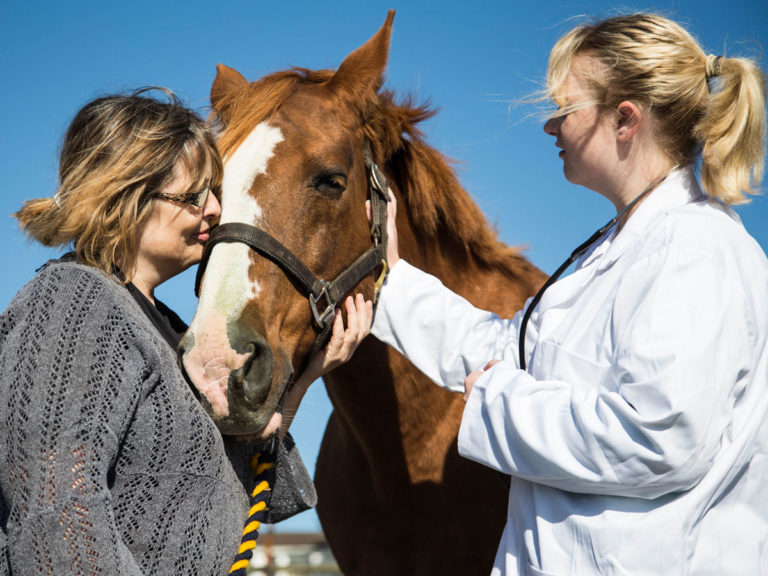The International Veterinary Information Service (IVIS) has announced the availability of the Proceedings of the American Association of Equine Practitioners (AAEP) 2015 Resort Symposium. The papers are available to registered IVIS members. You can visit IVIS.org and register or log in to read PDFs of the presentations.
17th Annual Resort Symposium of the AAEP, 2015 – Big Island, HI, USA
Current Conventional Treatments for Traumatic Joint Disease, by C.W. McIlwraith
Take Home Message: There are a number of options for the treatment of traumatic joint disease and recommendations have been modified based on new research and clinical evaluation in the field. Treatments that have received scientific validation include aquatic therapies, extracorporeal shock wave therapy, NSAIDs, intraarticular corticosteroids, intraarticular, intravenous and oral hyaluronan (HA), intraarticular polysulfated glycosaminoglycan and intramuscular pentosan polysulfate. There is limited scientific evidence for oral joint supplements.
New Biologic Therapies for Joint Disease, by C.W. McIlwraith
Take Home Message: Newer biologically based therapies involve two complementary approaches: 1) inhibiting cartilage breakdown (catabolism) and 2) enhancing cartilage synthesis (anabolism). Currently used therapies include autologous conditioned serum (ACS), which provides therapeutic effect by inhibiting interleukin-1 (IL-1) as well as increasing the anabolic growth factor concentrations. Its effectiveness as an intraarticular therapy has been defined. Platelet rich plasma (PRP) has bee n used intraarticularly but still requires further evidence for proof of efficacy
Mesenchymal Stem Cells – Appropriate Use in Equine Joint Disease, by C.W. McIlwraith
Take Home Message: Mesenchymal stem cells (MSCs) provide the potential to regenerate tissues without the production of scar tissue that is generally associated with healing in musculoskeletal tissues. At the moment , bone marrow-derived MSCs have received the most validation including demonstration of effectiveness intraarticularly to enhance soft tissue healing as well as improving articular cartilage repair. There is some evidence for usefulness with osteoarthritis (OA) and efficacy also demonstrated in augmentation of healing of injuries to the superficial digital flexor tendon as well as the suspensory ligament.
Current Surgical Versus Conservative Management in the Treatment of Osteochondritis Dissecans, by C.W. McIlwraith
Take Home Message: Conservative versus surgical options for the treatment of various entities of osteochondritis dissecans (OCD) exist. Treatment options when clinical signs are present include conservative and surgical options for femoropatellar, metacarpophalangeal/metatarsophalangeal and glenohumeral OCD depending on the nature of the lesion. In the tarsocrural joint, arthroscopic surgery is recommended for all cases accompanied by clinical signs. Treatment of radiographic lesions of OCD in yearlings is also practiced but must be accompanied with transparency with regard to those manipulations.
Treatment of Subchondral Cystic Lesions of the Stifle, by C.W. McIlwraith
Take Home Message: There are various manifestations of subchondral cystic lesions (SCLs). Treatment of clinically significant lesions revolves around Type 1 and Type 2 lesions. A consensus algorithm for treatment of SCLs of the medial femoral condyle (MFC) involves arthroscopic surgery and if the cyst has stable margins to a probe, and there is no penetration or collapse of the mar ins, intralesional corticosteroid injection is the first option. Cysts with collapsed margins are debrided. Failure to respond to intralesional corticosteroids leads to a recommendation of arthroscopic evacuation and debridement in an immature horse and arthroscopic debridement plus augmentation in an older horse. A recent option includes placement of a cortical bone screw across the lesion
Anovulatory Cycles, by L. Metcalf
Take Home Message: In the mare, the prediction of anovulatory follicles is often challenging. Although their etiology remains largely unknown, appropriate management of mares predisposed to anovulatory cycles may decrease their incidence.
Persistent Mating-Induced Endometritis, by L. Metcalf
Take Home Message: Persistent mating-induced endometritis in mares can often be managed effectively by using a combination of pharmaceutical agents, immunomodulation, and/or anatomical correction.
Advancing the Breeding Season – Overview, by L. Metcalf
Take Home Message: Due to the January 1st universal birth date set by many horse registries, breeders in the western hemisphere have sought means to produce foals early in the year before the natural physiological breeding season has be gun. Through both pharmacological and/and physiological manipulation of the hypothalamic-pituitary-ovarian axis, success can be achieved with a reasonable degree of predictability.
The Breeding Shed, by L. Metcalf
Take Home Message: The equine breeding shed requires conscientious and experienced horse handlers for smooth operation. The primary objective in the shed is the transfer of stallion semen, either by natural cover or collection, but the importance of safety, for both personnel and horses is sometimes overlooked. Many of the precautions taken to ensure safety with breeding stock not only protects horses and people also contribute to optimizing the quality of the ejaculate and improved biosecurity as well.
Assisted Reproductive Techniques, by L. Metcalf
Take Home Message: Assisted reproductive technologies (ART) are used in clinical practice for 2 main reasons—to increase the number of desired offspring from breeding stock beyond that which is physiologically feasible, or due to compromised fertility of the mare or stallion. Throughout the next decade, the client demand for many ART services will likely increase so that desired offspring are created. This will likely include a broader demand by breeders for preimplantation genetic diagnosis (PGD), which identifies not only gender of an embryo, but the carrier state of many heritable equine diseases, as well as preservation of valued genetic lines.








